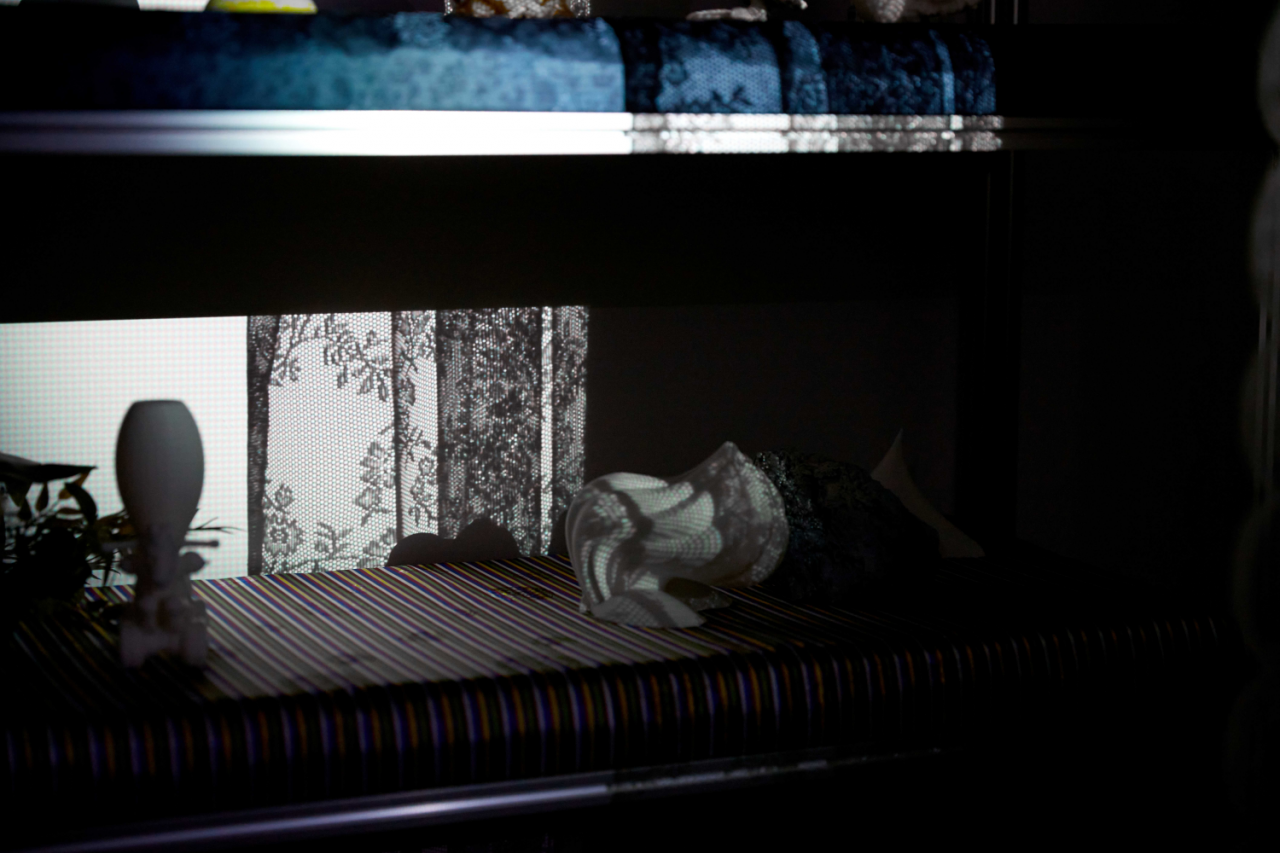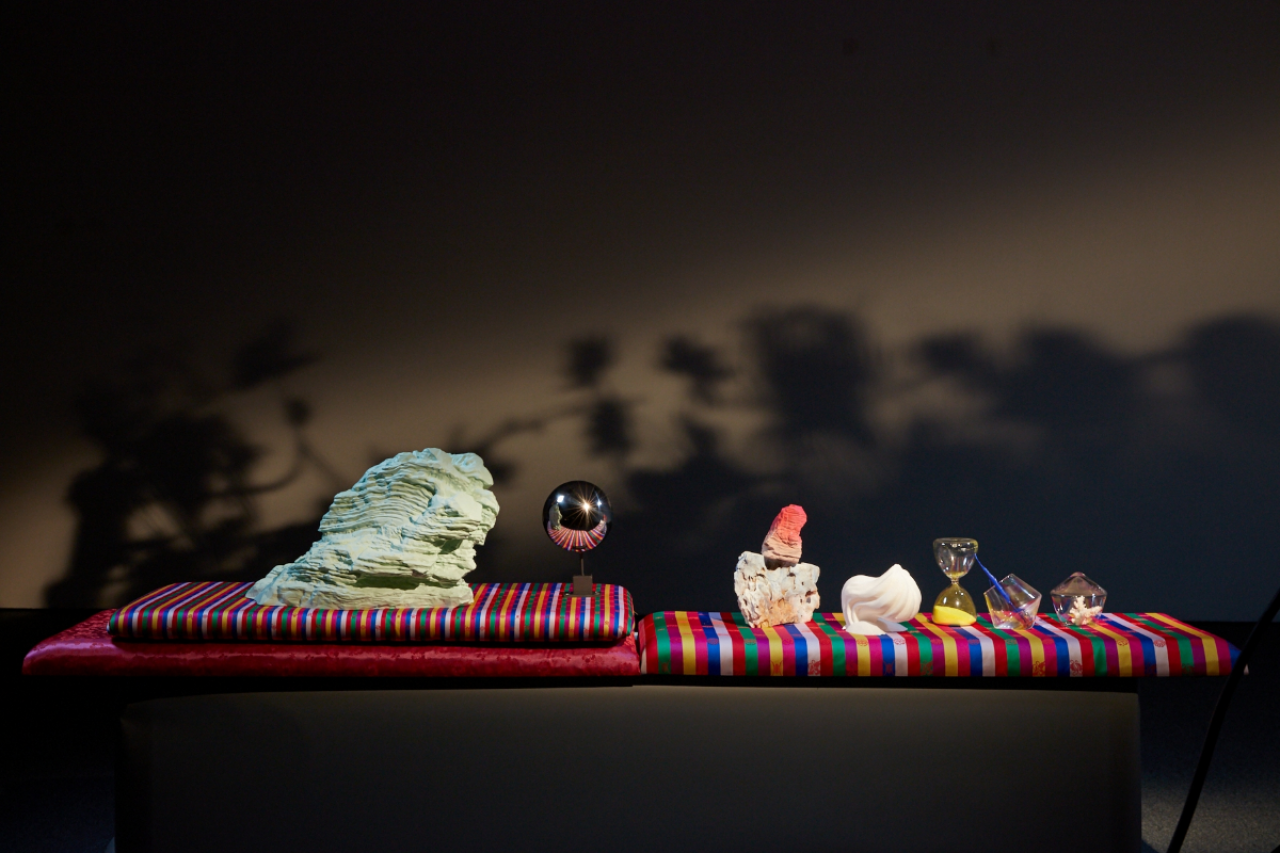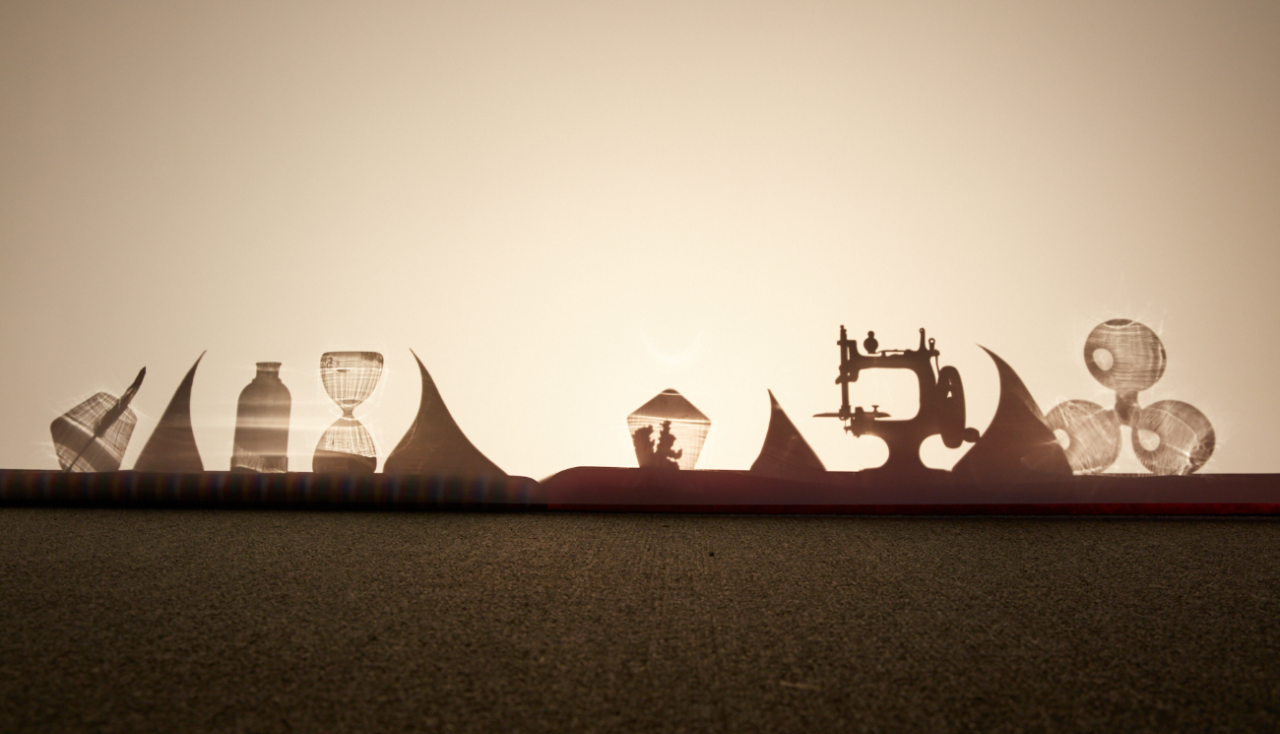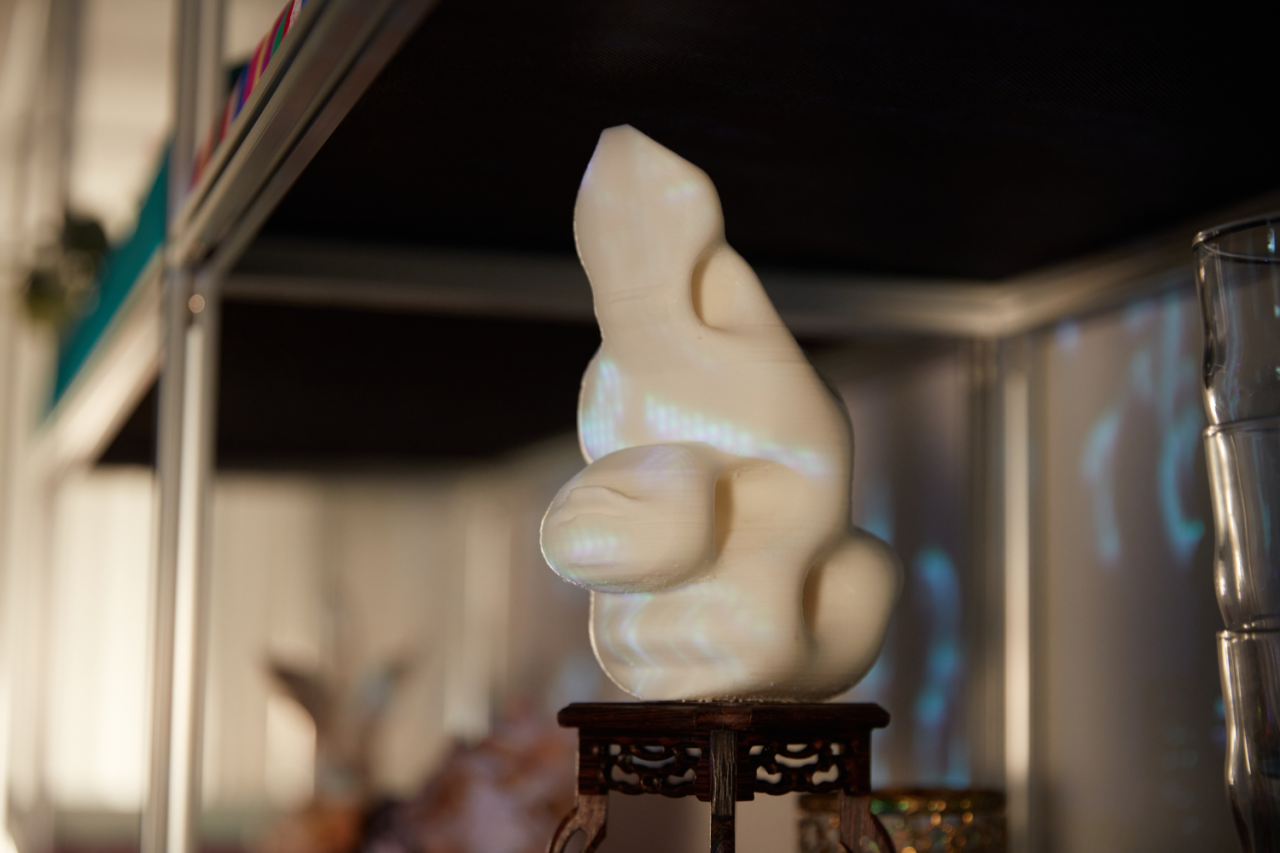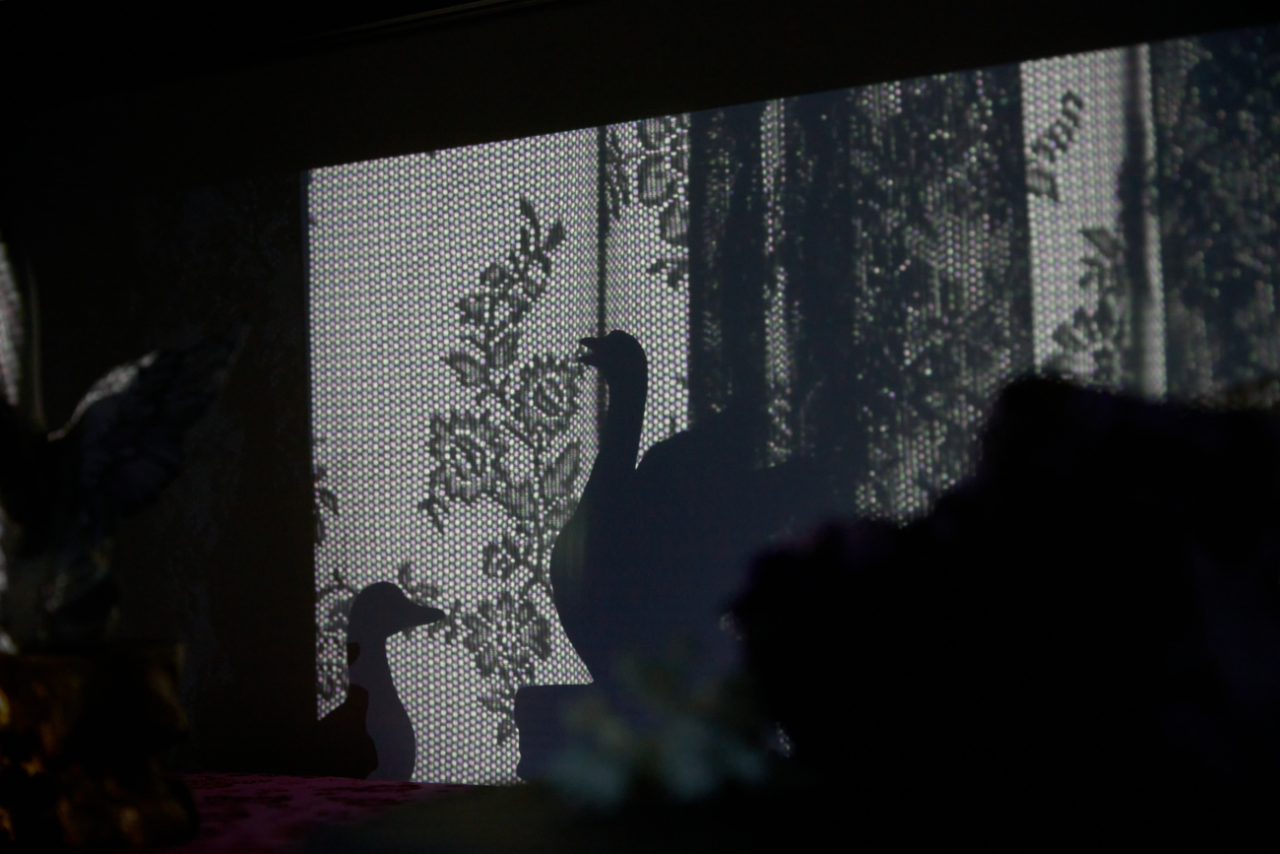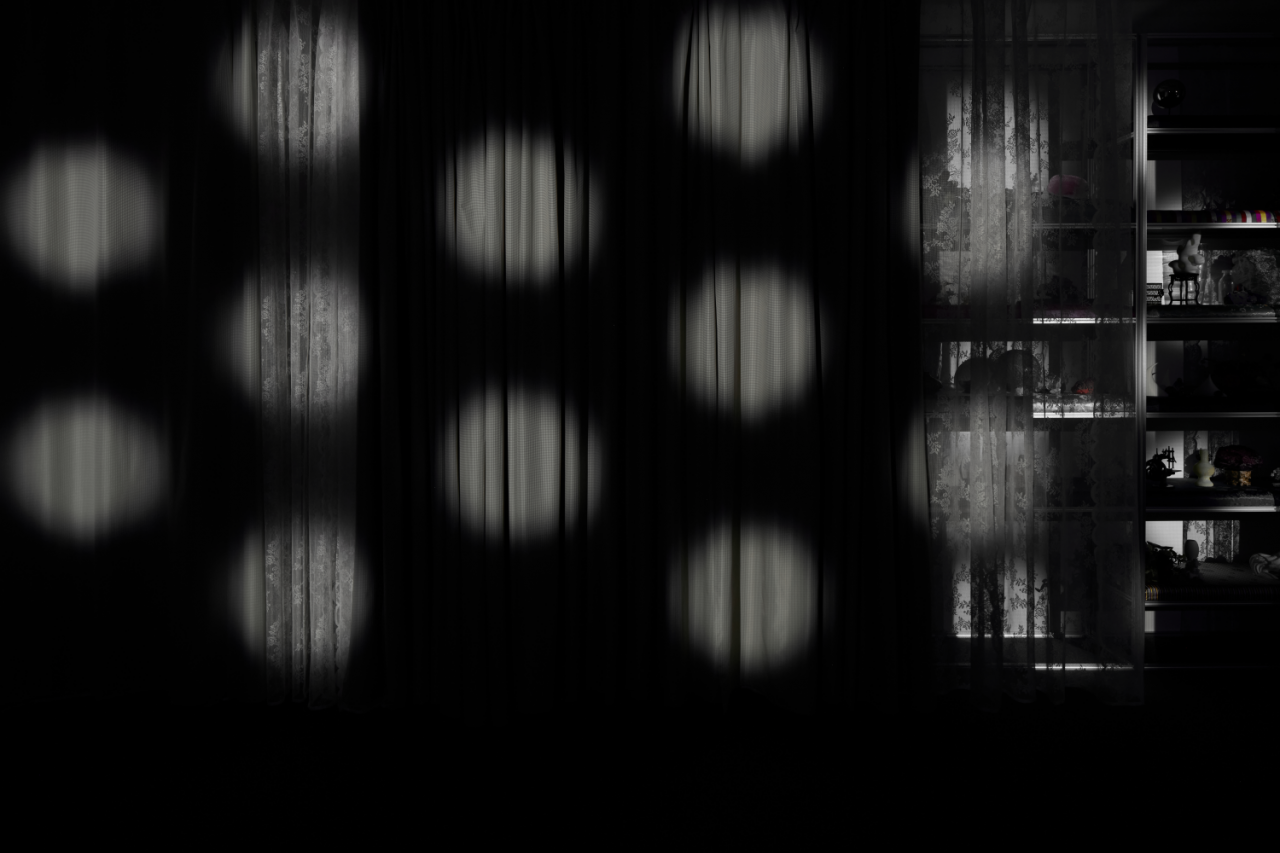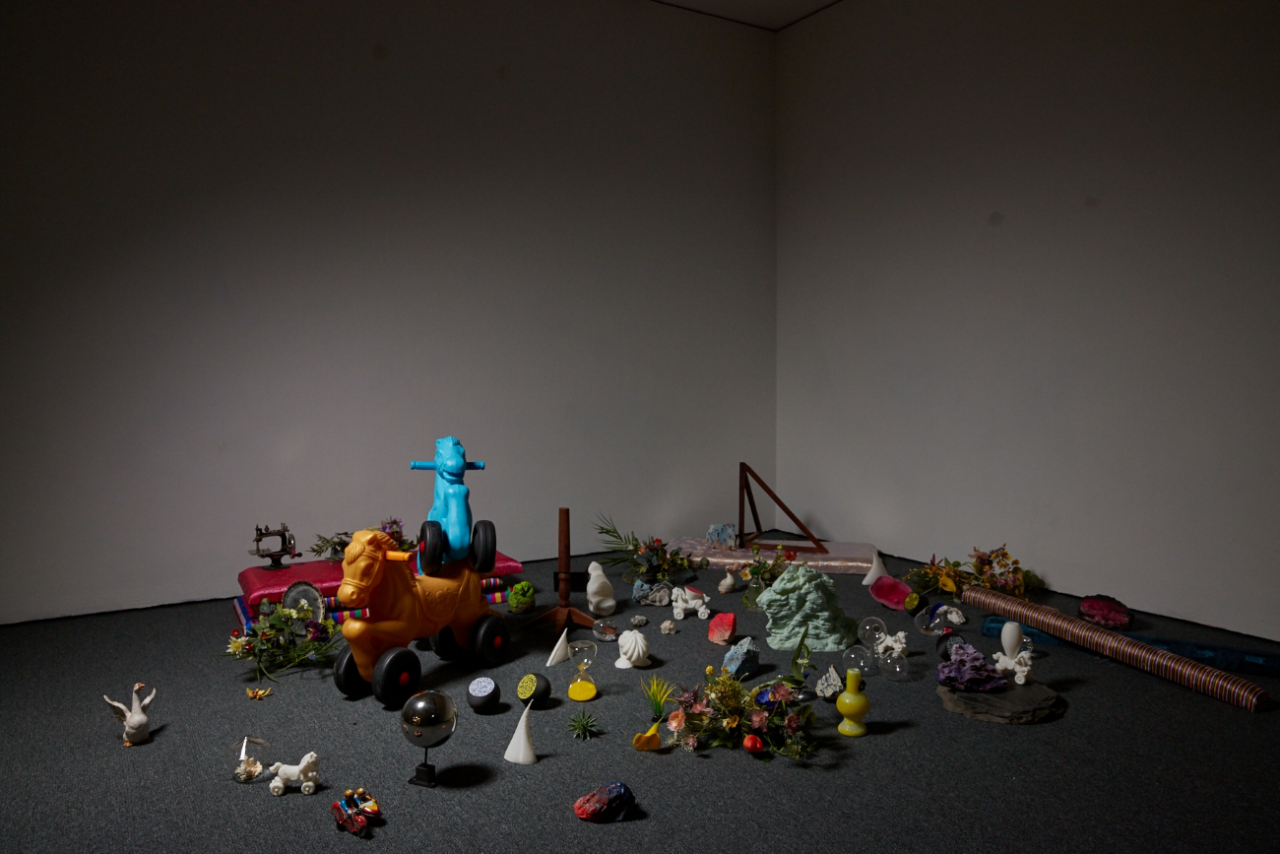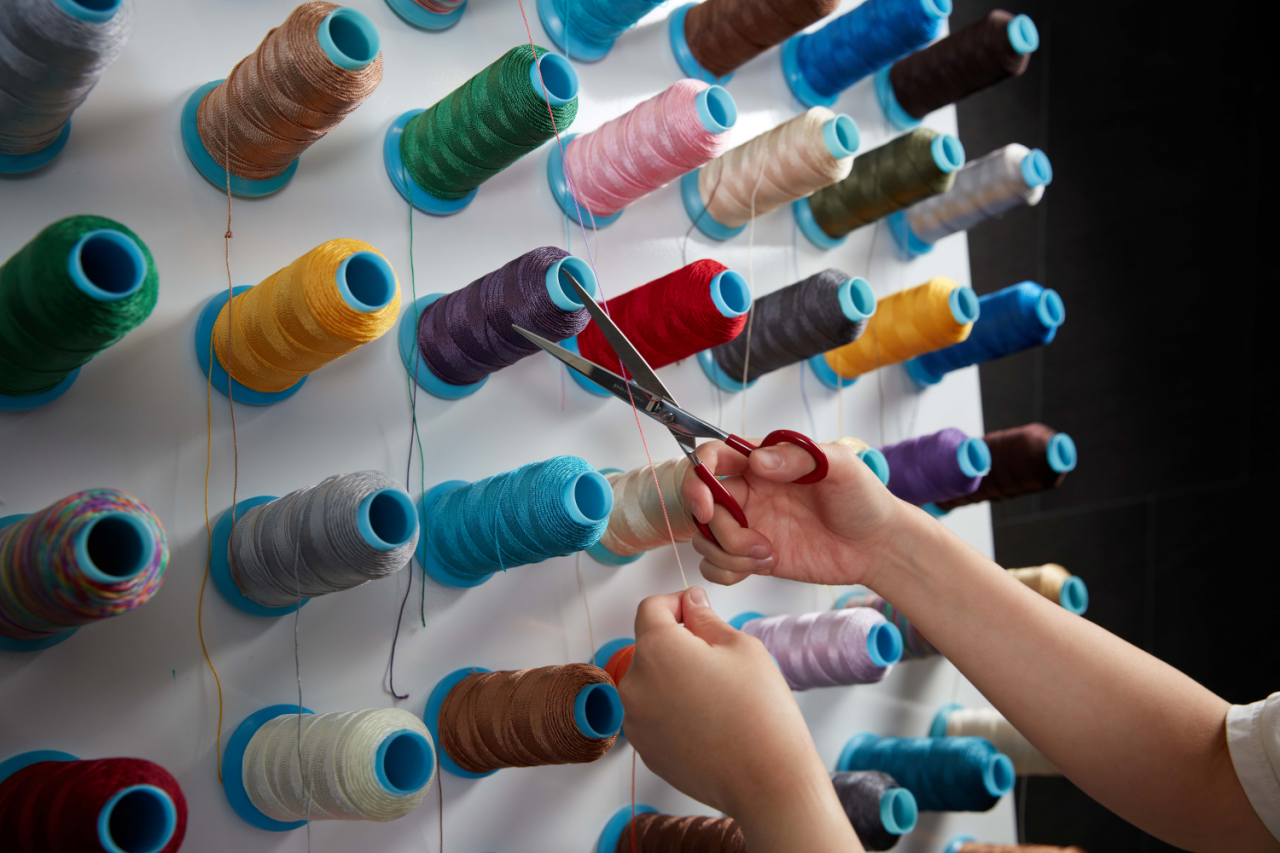Exhibitions
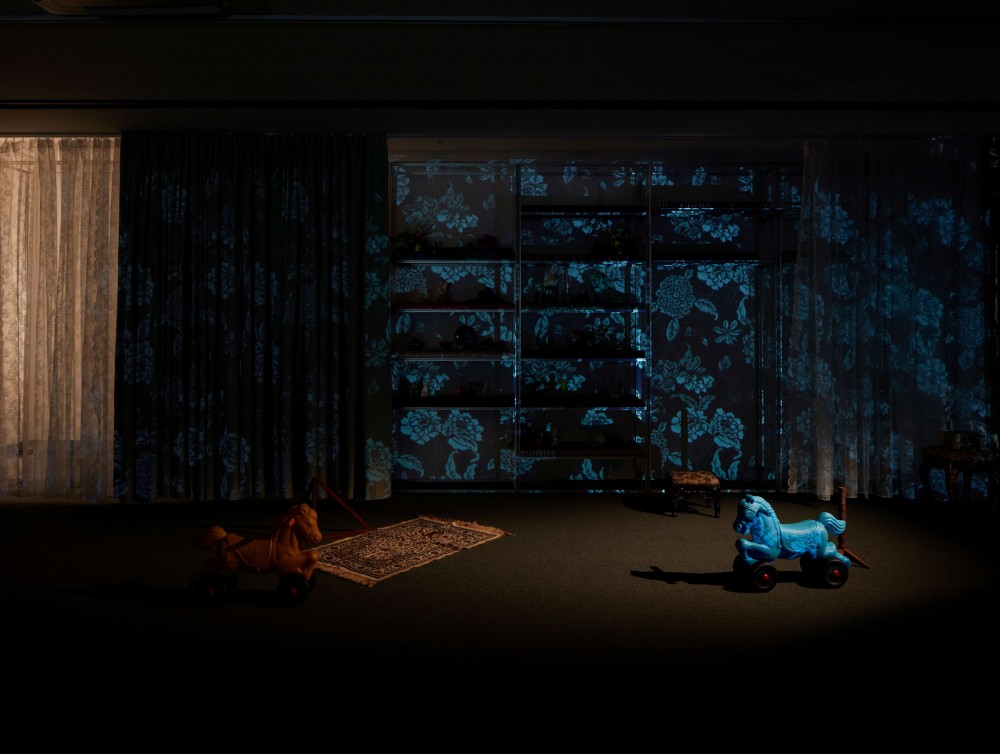
이예승
다락: 기억ㆍ구름ㆍ신기루
2025.10.13. MON ~
2025.11.29. SAT
<느끼고, 생각하고, 기억하기>
신승오 (페리지갤러리 디렉터)
이예승은 VR, AR, 3D프린터, AI를 비롯한 기술과 더불어 다양한 디지털 미디어를 통해 작업을 해오고 있다. 지금까지의 작업에서 나타난 특성은 이미 다른 글들에서 많이 언급되어 있기에 여기에서는 이번 전시에 대한 것에만 살펴보려 한다. 전시는 공간 입구에 놓인 실을 손에 들고 들어가면, 무엇인가가 투영된 커튼으로 쳐진 긴 벽을 마주하게 되고, 그 안에는 여러 사물이 설치되어 있고, 그 앞으로는 자유롭게 앉을 수 있는 것들이 배치되어 있다. 전시의 제목은 《다락: 기억, 구름, 신기루》로 우리는 먼저 다락에서부터 시작해 보자. 다락은 우리나라 전통 가옥에 있는 창고이다. 그것이 무엇인지 정확한 단어의 정의는 내버려두고 영화나 드라마에서 주인공이 방학을 맞이하여 시골의 외갓집 혹은 먼 친척 집을 방문하는 상황을 떠올려 보면 좋을 것 같다. 먼저 이곳저곳을 돌아다니다 마주친 창고의 문을 상상하면 된다. 당신은 평소 눈에 띄지 않았던 미지의 장소의 문을 열고 그곳을 들어가고 싶은 호기심이 발동할 것이다. 문을 열지 말지에 대한 고민을 마치고 마침내 낯선 곳으로 들어가는 모험의 순간이 주는 떨림, 두려움, 설렘이 뒤섞임 복잡한 감정이 일어날 것이다. 동시에 무엇인지 모를 물건들이 쌓여 있는 한눈에 파악되지 않는 어두움 속의 모습들과 함께 그곳을 채우고 있는 밖과 다른 공기의 냄새와 먼지를 느낀다. 이내....
Feeling, Thinking, and Remembering
Shin Seung Oh (Director, Perigee Gallery)
YeSeung LEE has been engaged in a variety of endeavors involving digital media and a range of technologies, including, but not limited to, VR, AR, 3D printers, and AI. The characteristics evident in her work to date have been extensively discussed in other writings, so here I will focus solely on this exhibition. When visitors enter the exhibition space holding a thread from the entrance, they encounter curtains that form a long wall-like barrier onto which something is projected. Inside, various objects are installed, and in front of them, seating arrangements are freely positioned. The exhibition is titled DARAK: Memory, Cloud, Mirage, so let us begin with Darak. Darak is a traditional Korean attic-like storage loft. Setting aside precise dictionary definitions, it would be helpful to imagine a scene from films or dramas where the protagonist visits a countryside grandparent's house or distant relative's home during vacation. First, picture wandering around and encountering the door of a storage room. You would feel curious about opening....
신승오 (페리지갤러리 디렉터)
이예승은 VR, AR, 3D프린터, AI를 비롯한 기술과 더불어 다양한 디지털 미디어를 통해 작업을 해오고 있다. 지금까지의 작업에서 나타난 특성은 이미 다른 글들에서 많이 언급되어 있기에 여기에서는 이번 전시에 대한 것에만 살펴보려 한다. 전시는 공간 입구에 놓인 실을 손에 들고 들어가면, 무엇인가가 투영된 커튼으로 쳐진 긴 벽을 마주하게 되고, 그 안에는 여러 사물이 설치되어 있고, 그 앞으로는 자유롭게 앉을 수 있는 것들이 배치되어 있다. 전시의 제목은 《다락: 기억, 구름, 신기루》로 우리는 먼저 다락에서부터 시작해 보자. 다락은 우리나라 전통 가옥에 있는 창고이다. 그것이 무엇인지 정확한 단어의 정의는 내버려두고 영화나 드라마에서 주인공이 방학을 맞이하여 시골의 외갓집 혹은 먼 친척 집을 방문하는 상황을 떠올려 보면 좋을 것 같다. 먼저 이곳저곳을 돌아다니다 마주친 창고의 문을 상상하면 된다. 당신은 평소 눈에 띄지 않았던 미지의 장소의 문을 열고 그곳을 들어가고 싶은 호기심이 발동할 것이다. 문을 열지 말지에 대한 고민을 마치고 마침내 낯선 곳으로 들어가는 모험의 순간이 주는 떨림, 두려움, 설렘이 뒤섞임 복잡한 감정이 일어날 것이다. 동시에 무엇인지 모를 물건들이 쌓여 있는 한눈에 파악되지 않는 어두움 속의 모습들과 함께 그곳을 채우고 있는 밖과 다른 공기의 냄새와 먼지를 느낀다. 이내 그 장소에 익숙해지고 공간이 밝아지면서 드러나는 형태 하나하나를 눈으로 살피고, 손으로 들춰내어 열고, 닫으며 꺼낸 것 중에 마음을 끄는 것들을 가지고 논다. 그리고 모든 것을 뒤로 한 채 그곳을 나와 내가 살던 현실의 장소로 돌아와 시간이 흘러가면, 서서히 그 경험은 기억에 파편으로 남아 심연으로 가라앉는다. 작가에게 이와 같은 다락은 이러한 이동과 접촉을 통해 다양한 감각적 경험을 하게 되는 현실이자 비현실의 공간이자, 무엇인가가 남겨진 비물질적 장소이다. 그렇다면 이 전시는 단순히 작가의 개인적인 경험을 통해 발생하는 감각을 우리에게 전달하기 위한 것일까?
기억
우리는 그 어느 때보다 많은 것에 연결되어 있다. 실체를 가진 현실은 가상의 세계와 지속적인 접촉을 하고 있으며, 우리는 수시로 그 경계를 넘나들고 있다. 그렇다 보니 현실과 비현실의 경계 사이에서 그것을 명확하게 구분하여 느끼거나 인식하는 것에 점점 무뎌지고 있는 것도 사실이다. 우리는 점점 더 어떤 일부, 큰 세계의 끝자락만 더듬으며 넓고 깊은 시공간을 떠도는 삶을 살고 있다고 할 수 있다. 그렇다면 이 같은 상황에서 구체적이고 명확한 실체를 가진 것은 무엇인가? 여기서 작가는 과거의 경험을 떠올리는 기억을 호출한다. 물론 여기에서 기억은 자기의 경험을 더듬어 나가는 일 다시 말해 이미 지나가 버려 비현실이 된 것을 다시 현실의 실재로 불러오는 과정을 거친다. 이는 머릿속에 떠오르는 일련의 흐릿한 이미지를 이어나가 명확한 하나의 장면으로 만들어 내지만 여전히 비물질적인 것으로 존재한다. 게다가 이를 가능하게 하는 것은 외부에 존재하는 막연하게 낯익고 익숙한 형태, 색, 빛, 그림자, 냄새, 촉감, 맛 같은 것과 기존의 비물질적인 경험을 동시에 소환하는 일이다. 그러나 이것은 단순히 지난날의 광경을 그려보면서 지금의 풍경과 비교하는 것과는 다르다. 그가 말하는 기억은 어떤 특별하고 명확한 인식이 아니라 불명확하고 흐릿하여 추상적이지만 새롭게 느껴지는 감각에 가깝다. 그는 커튼 뒤에 설치해 놓은 것들을 통해 관객들 각각이 지닌 잠재된 기억과 추상적인 감각이 자신의 작업과 접촉하는 순간 이전과는 다른 새로운 인식과 감각의 경험으로 전환하는 것을 기대한다. 분명히 내가 경험했지만 이미 지나가 버려 더 이상 현실의 실재가 아닌 것은 전시라는 새로운 경험을 통해 다시 일시적인 무엇으로 응축된다. 그럼에도 지금 우리는 급속도로 넓어지고 빠르게 변해가는 비선형적인 시공간 속에서 점점 더 현실이 존재하지 않는다는 느낌을 받는다. 그리고 우리는 여전히 모두 각자가 경험한 과거의 시간을 지나 여기에 도착하여 아직은 무엇인지 모를 것들 앞에 서 있다. 이런 모순적인 상황에서 기억은 작품을 보는 관객의 내면에 잠재해 있다가 다시 생생한 감각으로 되살아나 다층적 현실을 인식하게 만드는 요소이며, 작가는 그 본질에 다가가고자 한다.
구름
그렇다면 현재 우리의 기억은 어떻게 저장되는가? 앞에서 살펴본 것과 같이 우리 내부에 쌓이기만 하는 것이 아니라 사진과 영상 같은 구체적인 이미지나 글과 같은 기호로 남겨진다. 이제는 외부에 저장하는 방식이 하루가 다르게 발전하고 있고, 모든 것이 디지털화되어 다양한 장치를 통해 자동으로 즉시 옮겨지는 것에 익숙해져 있다. 그러므로 여기서 작가가 말하는 구름은 자연현상이 아니라 외부에 저장 창고로 사용되는 클라우드 서버 같은 것을 의미한다. 이렇듯 우리는 그 어느 때보다도 자기의 기억을 꺼내어 보기 쉬운 시대에 살고 있다. 그러나 SNS처럼 한편으로는 나의 내부에 존재하지 않는 기억의 한 단면들은 다른 사람과 공유되어 온전히 나의 것이라 확신할 수 없게 된다. 기억은 나에게서 비롯되었지만, 점점 더 다른 것이 될 가능성이 농후해진다. 그렇다면 기억은 무엇이 되어가는 걸까? 예전부터 우리는 도서관같이 공통의 지식을 보관하기 위한 장소를 만들어 왔다. 최근에는 다양한 방식의 아카이브를 구축하고 있는데. 예를 들면 전 지구의 유전자 정보나 씨앗 같은 근원적인 것들을 보존하고 보관하기 위한 공간이 운영된다. 이는 지구 안에서 발생하여 나타난 모든 것을 개별의 존재들이지만 공동의 것으로 바라보는 것이다. 그리고 이를 다시 활용하는 것은 또 다른 사용자들이 접속해서 그들만의 방식에 맡겨지는 것이다. 그것은 지구라는 한정된 공간 안에서 벌어지는 모든 것을 활성화하는 다중지성의 장을 구축하기 위한 방식이 된다. 따라서 개별의 기억은 공동의 기억으로 환원될 수 있다. 그렇다면 우리가 가진 개별의 기억은 실재에서 벗어나 새롭게 공유되는 공동의 감각으로의 가능성을 열어놓는다고 볼 수 있을 것이다. 이렇게 비현실로 사라져 버린 기억이라는 실재는 나의 것도 너의 것도 아닌 상태로 우리를 자유롭게 만들 수 있다. 우리 눈에 안 보이는 것은 사라진 것이 아니고, 어딘가에는 명확하게 존재하는 것이기에 우리는 단지 이것을 자유롭게 또 다른 현실로 가져와 계속해서 변형시키면서 우리에게 적용하기만 하면 된다. 이제 중요해진 것은 어떻게 실행해야 하는가이다. 이번 전시에서는 작가의 작업을 보기 위해 커튼을 열고, 닫고, 계단을 오르고 내리는 접촉의 움직임과 그 공간에 앉아 글을 읽거나 전시 전체를 관조하는 정적인 행위를 통해 이들을 응시할 수 있다. 위에서도 언급했듯이 그는 여전히 감각적 접촉과 관념적 사유를 통해 획득되는 흐릿하고 불완전해 보이는 사물에 대한 개인의 사적인 경험과 기억의 가능성을 믿는다. 그렇기에 그는 구름과 같이 공유되는 기억처럼 객관적으로 쌓여가는 정보와 함께 개인에 의해 사물의 본질이 감각적으로 나타나는 주관적 경험이 서로에게 기대며 접촉하는 그 사이에서 균형을 잡는 태도에 집중한다.
신기루
작가가 생각하는 균형은 어떻게 작동해야 하는 것일까? 우리가 흔히 말하는 사유와 성찰은 지금도 유효한 방식일까? 사실 무엇을 제대로 이해하거나 느끼려면 적당한 거리가 필요하다. 이는 물리적인 여기와 저기의 사이뿐만 아니라 시간적인 거리도 포함된다. 그의 작업과 우리가 무엇인가 느끼고 인식하는 그 사이의 간격은 좁혀질 수는 있지만 완벽하게 사라질 수는 없다. 이런 관점에서 우리가 작품을 본다는 것은 대상과의 거리를 조절해 나가는 과정이라고 볼 수 있다. 그가 말하는 신기루는 외부의 자연현상을 잘못 인식하여 실재하는 것으로 믿게 되고 가까이 다가가면 이내 사라져 허구로 인식된다. 그렇지만 그럼에도 그것은 분명히 그 순간에는 존재했던 현상임은 틀림없다. 이와 같은 현상이 나타나 존재하기 위해서는 결국 어느 정도의 거리가 필요하다. 이것은 하나의 비유에 지나지 않지만, 작가가 이야기하는 현실의 인식과 유사하다. 현재 우리에게는 어떤 정보든 즉시 전달되어 시간적 거리는 느껴지지 않을 만큼 서로 맞닿아있다. 위에서 살펴본 것처럼 그 경험이 저장되는 것도 시간과 장소에 구애받지 않는다. 하지만 최대한 밀착된 시간은 우리에게 뭔가를 숙고할 기회를 상실하게 만든다. 이러한 상황에서 무엇인 가를 느끼고 인식하는 것은 즉각적인 감각적 충격 이후에 이들을 빠르게 재조합하는 과정만이 발달할 수밖에 없고, 이에 따라 촘촘하게 구축되는 수많은 교차점만이 생성될 뿐이다. 이런 인식의 방식은 일견 모든 것이 순식간에 지나쳐버려 무의미한 것으로 느껴져 그저 무엇인가를 경험했다는 사실만 남게 될 수도 있다. 만약 내가 세계로부터 무언가를 확실한 것으로 받아들일 수 있다면, 그것은 기억을 바탕으로 한 관념의 인식과 감정의 감각을 통해서일까? 물론 이들은 모두 나를 기만할 수 있다. 그렇기에 작가는 이것을 제대로 활성화하기 위해 사유의 시간이 필요하다는 것을 이야기한다. 이를 위해 그는 전시장을 물질의 존재 양태인 형태, 밀도, 움직임 외에도 이들이 놓인 공간적 속성과 시간적 속성에서 기인하는 빛, 색, 공기와 같은 분위기를 환기하기 위한 동적이면서도 정적인 시간과 공간으로 유도한다. 이는 허상인 신기루를 현실에 계속해서 존재하는 새로운 실재로 남겨놓기 위해 서로의 거리를 천천히 느끼고 생각하게 하려는 그의 사유에 관한 생각을 담고 있다.
그리고 실
지금까지 살펴본 기억, 구름, 신기루의 다층적 상황은 비현실이든 현실이든 내가 지금 느끼는 바로 그 순간이 실재이다. 이번 전시에서 우리는 실을 가지고 전시장에 들어간다. 현실 속의 비현실인 전시장에서 이 얇고 가는 실은 내가 어떤 현실에 있음을 때때로 알려주는 도구로 작용한다. 이렇게 우리가 지금 바로 느꼈지만, 순식간에 사라져 버린 경험은 오히려 현실에서 멀어진 가상이다. 그렇지만 실재와 가상, 비현실과 현실은 모두 분명히 어떤 감각적 잔재를 남긴다. 사실 우리가 작품을 보는 것은 이런 것들을 바탕으로 보이는 대로 보는 것, 보이지 않는 것을 찾아내는 것, 보이는 데도 보지 못하는 것, 보이지 않는 것에서 보이는 것을 찾는 것이 된다. 그렇다고 해서 지금의 감각과 관념이 모든 것을 결정짓는 절대적 기준이 될 수 없다. 오히려 과거와 현재를 연결하는 기억과 현재의 관념과 감각이 복잡하게 접촉과 끊어짐을 반복하며 유동적으로 움직이는 관계만을 드러낸다. 따라서 잠시 붙잡아 놓는 일시적 경험에 불과한 것에서 벗어나 무엇인가를 어떤 온전한 것으로 인식하기 위해서는 작가가 이야기하는 사유의 과정이 필요하다. 이것은 내가 바라보는 대상과의 긴장과 이완을 통해 외부와 내부의 감각과 관념을 드러내면서도 이내 거리를 두는 것과 같은 태도를 가질 때 유효하다. 결국 이예승이 이번 전시를 통해 의도하는 바는 우리가 현실과 비현실의 경계의 느슨함을 넘어 공유할 수 있는 가상과 공유 불가능한 현실을 이어 나가며 서서히 드러나는 형체와 감촉의 가능성을 열어 보이는 것이다. 그리고 그가 이야기하는 사유는 우리 손에 쥐어진 실처럼 어떤 결론으로 무엇이 되고자 하는 그 끝을 지연시키기 위해 지금의 현실 혹은 비현실을 어느 한쪽으로 치우치지 않게 계속해서 이 순간을 의심하게 만드는 바로 그것이다. 그러니 이제 그의 작업을 느끼고, 생각하고, 기억하며, 당신의 다락을 새롭게 채워 나가자.
Shin Seung Oh (Director, Perigee Gallery)
YeSeung LEE has been engaged in a variety of endeavors involving digital media and a range of technologies, including, but not limited to, VR, AR, 3D printers, and AI. The characteristics evident in her work to date have been extensively discussed in other writings, so here I will focus solely on this exhibition. When visitors enter the exhibition space holding a thread from the entrance, they encounter curtains that form a long wall-like barrier onto which something is projected. Inside, various objects are installed, and in front of them, seating arrangements are freely positioned. The exhibition is titled DARAK: Memory, Cloud, Mirage, so let us begin with Darak. Darak is a traditional Korean attic-like storage loft. Setting aside precise dictionary definitions, it would be helpful to imagine a scene from films or dramas where the protagonist visits a countryside grandparent's house or distant relative's home during vacation. First, picture wandering around and encountering the door of a storage room. You would feel curious about opening the door to this unknown place that had previously escaped your notice. After deliberating whether to open the door, you would experience a complex mix of emotions—trembling, fear, and excitement—at the adventurous moment of finally entering this unfamiliar place. Simultaneously, you would sense the indiscernible shapes in the darkness where unidentifiable objects are piled up, along with the scent of air different from the outside and the dust filling that space. Soon, you would become accustomed to the place, and as the space brightens, you would examine each revealed form with your eyes, open and close things by hand, and play with the appealing objects you discover. Then, leaving everything behind, you would exit that place and return to the reality of your everyday life. As time passes, this experience gradually settles into the depths of your memory as fragments. For LEE, such Darak represents both a real and unreal space where various sensory experiences occur through movement and contact, as well as an immaterial place where something remains. But is this exhibition simply meant to convey the sensations arising from LEE's personal experiences to us?
Memory
We are connected to more things than ever before. The physical world is in constant contact with the virtual world, and we are always crossing these boundaries. Consequently, we are indeed becoming increasingly dulled to clearly distinguishing and perceiving the boundaries between reality and unreality. We can say that we live increasingly drifting through vast and deep spacetime, feeling our way along only fragments, the edges of some larger world. What, then, possesses concrete and clear substance in such circumstances? Here, LEE invokes memory—the recollection of past experiences. Of course, memory here involves tracing one's experiences, that is, the process of bringing what has already passed and become unreal back into reality as substance. This creates a clear scene by connecting a series of hazy images that arise in the mind, yet it continues to exist as something immaterial. Moreover, what makes this possible is the simultaneous summoning of existing immaterial experiences alongside external elements—forms, colors, light, shadows, scents, textures, and tastes—that are vaguely familiar and recognizable. However, this differs from simply drawing scenes from the past and comparing them with present landscapes. The memory she speaks of is not some special and clear recognition, but rather approaches a new sensation that feels abstract yet fresh despite being unclear and hazy. Through the objects she has installed behind the curtains, she expects that each viewer's latent memories and abstract sensations will transform into new experiences of recognition and sensation different from before when they come into contact with her work. What I have certainly experienced but has already passed and is no longer real substance becomes condensed again into some temporary form through the new experience of the exhibition. Nevertheless, we increasingly feel that reality does not exist within the rapidly expanding and quickly changing non-linear spacetime we inhabit. And we all still stand before things we do not yet understand, having arrived here through the past times each of us has experienced. In such contradictory circumstances, memory is an element that lies dormant within the viewer's inner self and then revives as vivid sensation, enabling recognition of multilayered reality, and LEE seeks to approach this essence.
Cloud
How, then, is our memory currently stored? As we have seen, it is not merely accumulated within us but is preserved as concrete images like photographs and videos or as symbols like text. External storage methods are now developing at an unprecedented pace, and we have become accustomed to everything being digitized and automatically transferred instantly through various devices. Therefore, the cloud that LEE refers to here does not mean natural phenomena but rather something like cloud servers used as external storage warehouses. Thus, we live in an era where it is easier than ever to retrieve and examine our own memories. However, aspects of memory that do not exist within me, like those on social media, become shared with others, making us unable to be certain that they are entirely our own. Memory originates from me, yet increasingly tends to become something else. What, then, is memory becoming? We have long created places like libraries to preserve common knowledge. Recently, we are building various types of archives—for example, spaces operate to preserve and store fundamental things like genetic information or seeds from across the globe. This involves recognizing everything that has emerged on Earth as individual existences yet as collective property. And utilizing this again is left to the approaches of other users who access it. This becomes a method for building a field of collective intelligence that activates everything occurring within the limited space called Earth. Therefore, individual memory can be reduced to collective memory. Thus, we can see that the individual memories we possess open up possibilities for newly shared collective sensation, departing from reality. Memory as substance that has disappeared into unreality in this way can free us in a state that belongs neither to me nor to you. What is invisible to us has not disappeared but exists clearly somewhere, so we need only freely bring this into another reality and continue transforming it while applying it to ourselves. What has become important now is how to execute this. In this exhibition, viewers can gaze upon these through the contact movements of opening and closing curtains, ascending and descending stairs to view LEE's work, and through the static acts of sitting in that space to read or contemplate the exhibition as a whole. As mentioned above, she still believes in the possibility of individual private experiences and memories of objects that appear hazy and incomplete, acquired through sensory contact and conceptual thinking. Therefore, she focuses on an attitude that finds balance in the space where objectively accumulated information like cloud-shared memory and subjective experiences where the essence of objects appears sensory through individuals lean on each other and make contact.
Mirage
How should the balance that LEE envisions operate? Are the thinking and reflection we commonly speak of still valid approaches? After all, properly understanding or feeling something requires appropriate distance. This includes not only physical distance between here and there but also temporal distance. The gap between her work and our feeling and recognizing something can be narrowed but cannot completely disappear. From this perspective, viewing artwork can be seen as a process of adjusting distance with the object. The mirage she speaks of involves misperceiving external natural phenomena, believing them to be real, but when we approach closely, they soon disappear and are recognized as fiction. Nevertheless, it was certainly a phenomenon that existed in that moment. For such phenomena to appear and exist ultimately requires some degree of distance. This is merely an analogy, but it resembles LEE's understanding of reality perception. At present, any information is transmitted to us instantly, with temporal distances so close as to be imperceptible. As mentioned earlier, the storage of such experiences is also unconstrained by time and place. However, maximally compressed time makes us lose opportunities for contemplation. In such circumstances, feeling and recognizing something can only develop the process of rapidly recombining after immediate sensory impact, thereby generating only numerous densely constructed intersection points. This way of recognition might make everything seem to pass by instantly and feel meaningless, leaving only the fact that we have experienced something. If I could accept something from the world as certain, would it be through the recognition of ideas based on memory and the sensation of emotions? Of course, these could all deceive me. Therefore, LEE argues that time for thinking is necessary to properly activate this. For this purpose, she guides the exhibition space into dynamic yet static time and space that evokes not only the material existence modes of form, density, and movement but also the atmosphere of light, color, and air arising from their spatial and temporal properties. This contains her thoughts about thinking—making us slowly feel and consider mutual distances in order to leave the illusion of mirage as new substance that continues to exist in reality.
And Thread
The multilayered situation of memory, the cloud, and the mirage that we have examined—whether they are real or unreal—makes this very moment real. In this exhibition, we enter the exhibition space holding thread. In the exhibition space that is unreality within reality, this thin, fine thread serves as a tool that occasionally informs us of what reality we are in. What we have just felt but instantly disappeared becomes virtuality that has moved away from reality. However, substance and virtuality, unreality and reality all certainly leave some sensory residue. In fact, viewing artwork based on these things becomes seeing what appears as it appears, discovering what is invisible, not seeing what is visible, and finding the visible in the invisible. However, current sensations and concepts cannot become absolute standards that determine everything. Rather, they reveal only relationships that move fluidly through complex patterns of contact and disconnection between memories connecting past and present and current concepts and sensations. Therefore, to recognize something as complete rather than remaining in temporary experiences that are merely momentarily grasped, the process of thinking that LEE discusses is necessary. This becomes effective when we adopt an attitude of revealing external and internal sensations and concepts through tension and relaxation with the object we observe while maintaining distance. Ultimately, what YeSeung LEE intends through this exhibition is to open up possibilities for forms and textures that gradually reveal themselves by continuing to connect shareable virtuality and unshareable reality, transcending the looseness of boundaries between reality and unreality. And the thinking she discusses is precisely what makes us continue to doubt this moment so as not to lean toward either current reality or unreality, in order to delay the end of becoming something with some conclusion—like the thread held in our hands. So now, let us feel, think, and remember her work, and newly fill your Darak.



